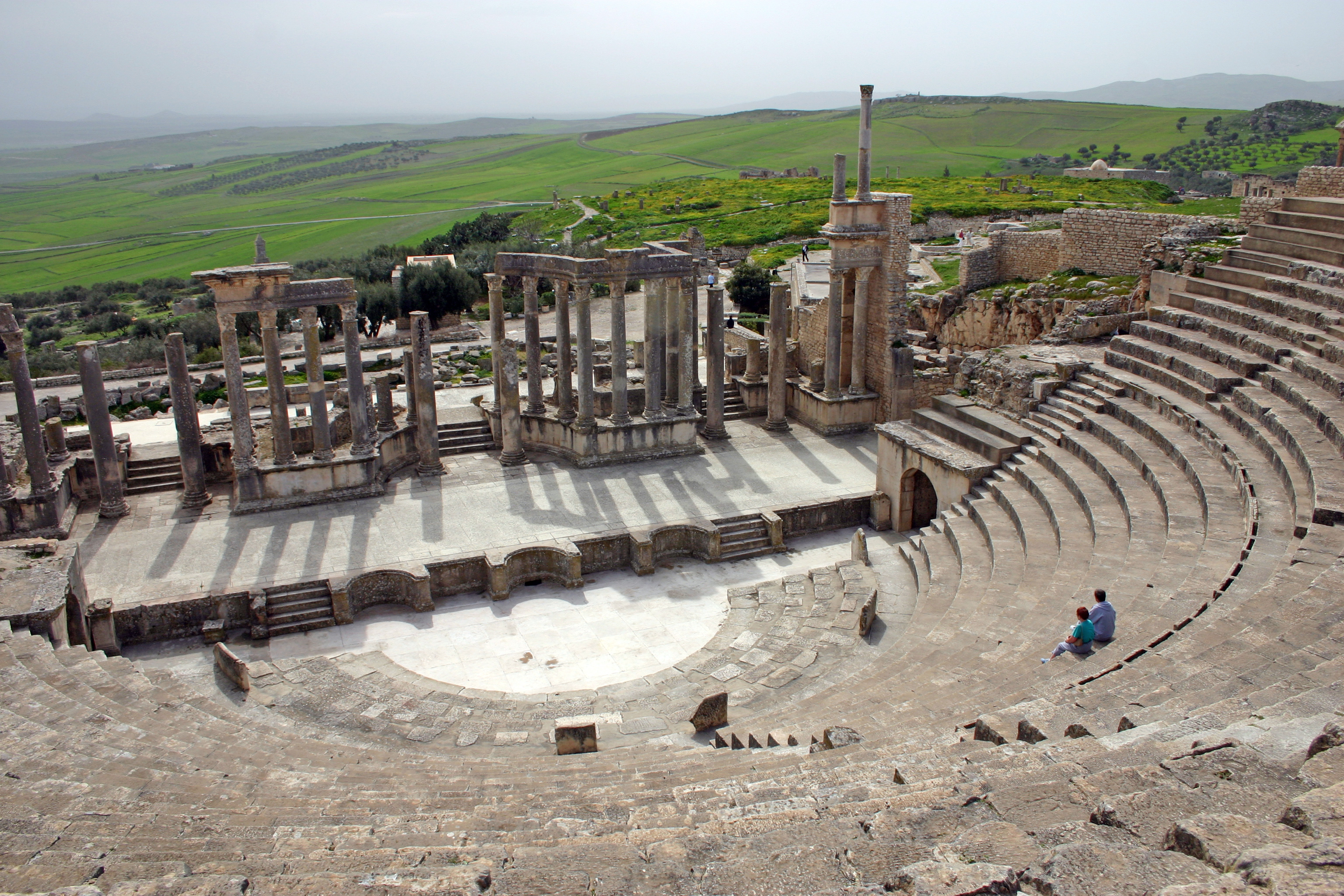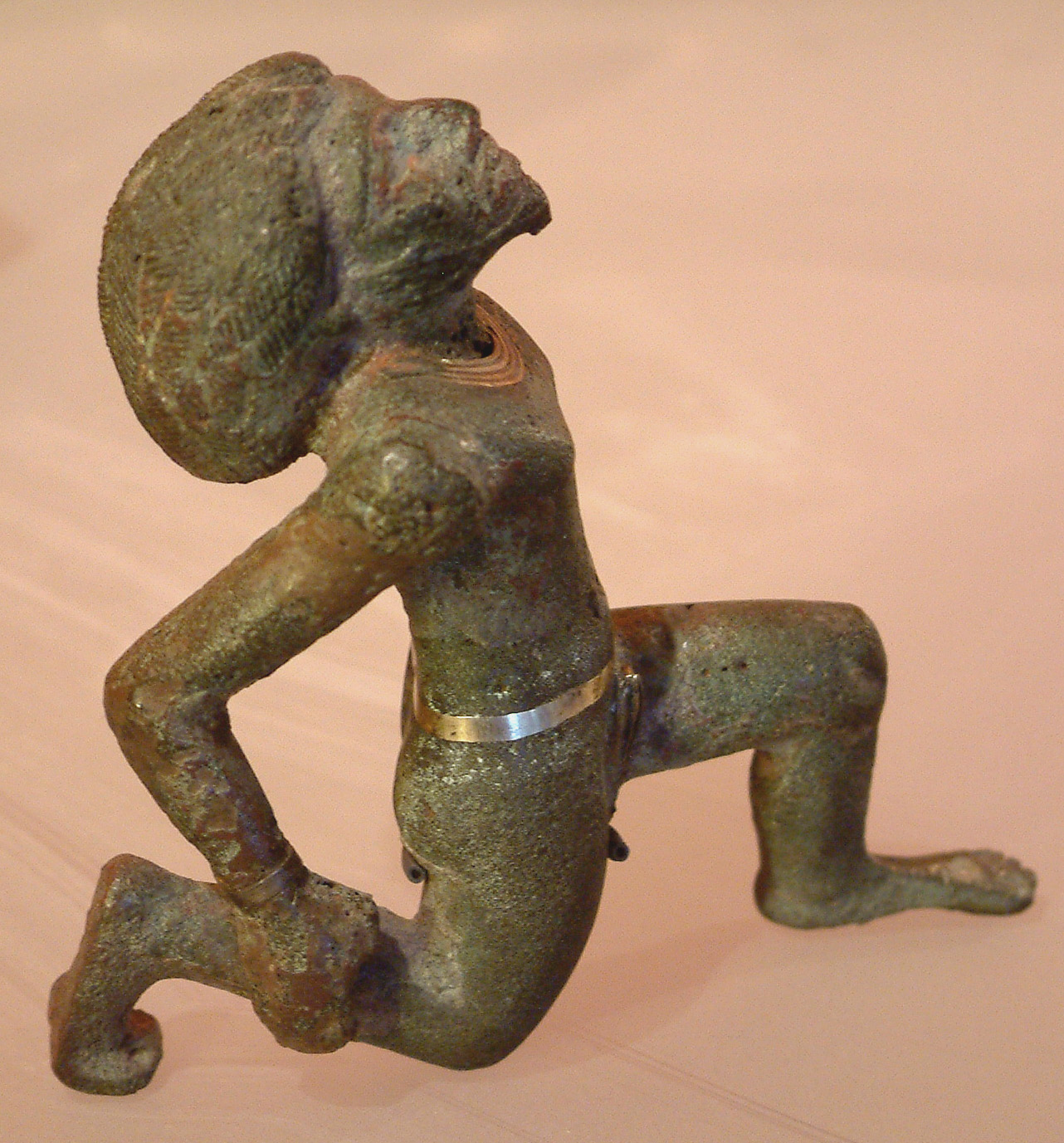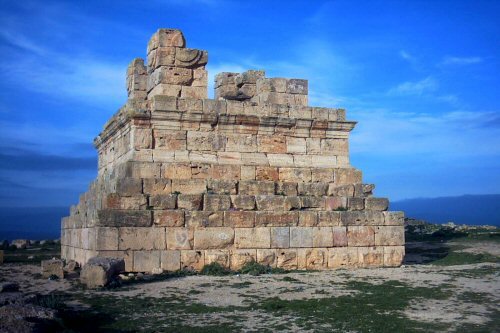|
Dougga
Dougga or Thugga or TBGG was a Berber, Punic and Roman settlement near present-day Téboursouk in northern Tunisia. The current archaeological site covers . UNESCO qualified Dougga as a World Heritage Site in 1997, believing that it represents "the best-preserved Roman small town in North Africa". The site, which lies in the middle of the countryside, has been protected from the encroachment of modern urbanization, in contrast, for example, to Carthage, which has been pillaged and rebuilt on numerous occasions. Dougga's size, its well-preserved monuments and its rich Numidian- Berber, Punic, ancient Roman and Byzantine history make it exceptional. Amongst the most famous monuments at the site are a Libyco-Punic Mausoleum, the Capitol, the Roman theatre, and the temples of Saturn and of Juno Caelestis. Names The Numidian name of the settlement was recorded in the Libyco-Berber alphabet as TBGG. The Punic name of the settlement is recorded as () and (). The Root B GG in Ph ... [...More Info...] [...Related Items...] OR: [Wikipedia] [Google] [Baidu] |
Libyco-Punic Mausoleum Of Dougga
The Libyco-Punic Mausoleum of Dougga (Mausoleum of Atban) is an ancient mausoleum located in Dougga, Tunisia. It is one of three examples of the royal architecture of Numidia, which is in a good state of preservation and dates to the 2nd century BC. It was restored by the government of French Tunisia between 1908-10. As part of the site of Dougga, the mausoleum is listed by UNESCO as a World Heritage Site. On 17 January 2012, the Tunisian government proposed it be included in a future classification of the royal mausoleums of Numidia and Mauretania and other pre-Islamic funerary monuments. History The first westerners to visit the site of Dougga arrived in the 17th century, becoming more frequent throughout the nineteenth century. The mausoleum was described by several of these tourists and was the object of early architectural studies at the end of the period. In 1842, the British consul in Tunis Thomas Reade seriously damaged the monument in the process of removing the roya ... [...More Info...] [...Related Items...] OR: [Wikipedia] [Google] [Baidu] |
Roman Theatre Of Dougga
The Roman theatre of Dougga is an ancient theatre located in Teboursouk in the north-west of Tunisia. History Like all the other Roman cities of North Africa from the reign of Augustus, Dougga had its own theatre. According to historians, the monument was built between 168 and 169. It is located in the eastern part of the archeological site Dougga, and can host over 3500 spectators. The theatre got classified as a monument on 8 June 1891. It is considered as one of the best preserved examples of theatres in Roman Africa Nowadays, it hosts every year the activities of the Dougga's international festival. Architecture A dedication engraved into the pediment of the stage and on the portico the dominates the city, recalls the building's commissioner, P. Marcius Quadratus, who "built tfor his homeland with his own denarii The denarius (, dēnāriī ) was the standard Roman silver coin from its introduction in the Second Punic War to the reign of Gordian III (AD 238� ... [...More Info...] [...Related Items...] OR: [Wikipedia] [Google] [Baidu] |
Libyco-Berber Alphabet
The Libyco-Berber alphabet or the Libyc alphabet (modern Berber name: ''Agemmay Alibu-Maziɣ'') is an abjad writing system that was used during the first millennium BC by various Berber peoples of North Africa and the Canary Islands, to write ancient varieties of the Berber language like the Numidian language in ancient North Africa. The Libyco-Berber script is found in thousands of stone inscriptions and engravings throughout Morocco, northern Algeria, Tunisia, northern Libya and the Canary Islands. Apart from thousands of small inscriptions, some of the best known and significant Libyco-Berber inscriptions are in the Massinissa Temple (discovered in 1904) and the Prince Ateban Mausoleum in Dougga / Thugga (TBGG), northern Tunisia. Other significant Libyco-Berber inscription are the Azib N'Ikkis and the Oukaimeden, both found in the High-Atlas Mountains of Morocco. The use of the Libyco-Berber alphabet died out in northern areas during or after the reign of the Roman and B ... [...More Info...] [...Related Items...] OR: [Wikipedia] [Google] [Baidu] |
Berbers
, image = File:Berber_flag.svg , caption = The Berber ethnic flag , population = 36 million , region1 = Morocco , pop1 = 14 million to 18 million , region2 = Algeria , pop2 = 9 million to ~13 million , region3 = Mauritania , pop3 = 2.9 million , region4 = Niger , pop4 = 2.6 million, Niger: 11% of 23.6 million , region5 = France , pop5 = 2 million , region6 = Mali , pop6 = 850,000 , region7 = Libya , pop7 = 600,000 , region8 = Belgium , pop8 = 500,000 (including descendants) , region9 = Netherlands , pop9 = 467,455 (including descendants) , region10 = Burkina Faso , pop10 = 406,271, Burkina Faso: 1.9% of 21.4 million , region11 = Egypt , pop11 = 23,000 or 1,826,580 , region12 = Tunisia , pop12 ... [...More Info...] [...Related Items...] OR: [Wikipedia] [Google] [Baidu] |
Berber People
, image = File:Berber_flag.svg , caption = The Berber flag, Berber ethnic flag , population = 36 million , region1 = Morocco , pop1 = 14 million to 18 million , region2 = Algeria , pop2 = 9 million to ~13 million , region3 = Mauritania , pop3 = 2.9 million , region4 = Niger , pop4 = 2.6 million, Niger: 11% of 23.6 million , region5 = France , pop5 = 2 million , region6 = Mali , pop6 = 850,000 , region7 = Libya , pop7 = 600,000 , region8 = Belgium , pop8 = 500,000 (including descendants) , region9 = Netherlands , pop9 = 467,455 (including descendants) , region10 = Burkina Faso , pop10 = 406,271, Burkina Faso: 1.9% of 21.4 million , region11 = Egypt , pop11 = 23,000 or 1,826,580 , region12 = Tunisia , ... [...More Info...] [...Related Items...] OR: [Wikipedia] [Google] [Baidu] |
Tunisia
) , image_map = Tunisia location (orthographic projection).svg , map_caption = Location of Tunisia in northern Africa , image_map2 = , capital = Tunis , largest_city = capital , coordinates = , official_languages = Arabic Translation by the University of Bern: "Tunisia is a free State, independent and sovereign; its religion is the Islam, its language is Arabic, and its form is the Republic." , religion = , languages_type = Spoken languages , languages = Minority Dialects : Jerba Berber (Chelha) Matmata Berber Judeo-Tunisian Arabic (UNESCO CR) , languages2_type = Foreign languages , languages2 = , ethnic_groups = * 98% Arab * 2% Other , demonym = Tunisian , government_type = Unitary presidential republic , leader_title1 = President , leader_name1 = Kais Saied , leader_ti ... [...More Info...] [...Related Items...] OR: [Wikipedia] [Google] [Baidu] |
Numidian Language
Numidian was a language spoken in ancient Numidia, a territory covering much of northern Africa. The script in which it was written, the Libyco-Berber alphabet (from which Tifinagh descended), has been almost fully deciphered and most characters (apart from a few exceptions restricted to specific areas) have known values. Despite this, the language has barely been deciphered and only a few words are known. Libyco-Berber inscriptions are attested from the 3rd century BC to the 3rd century AD. The language is scarcely attested and can be confidently identified only as belonging to the Afroasiatic languages, Afroasiatic family, although it was most likely part of the Berber languages, spoken at the start of the breakup of the Proto-Berber language. Dialects and relation to other ancient languages Dialects and foreign influences It is known that there was an orthographical difference between the western and eastern Numidian language. Starting at Kabylia, which was a kind of mixed ... [...More Info...] [...Related Items...] OR: [Wikipedia] [Google] [Baidu] |
Téboursouk
Téboursouk ( aeb, تبرسق ') is a town and commune in the Béja Governorate, Tunisia. It is located at 36° 27′ 26″N, 009° 14′ 54″E. Population In 2004 it had a total population of 10,987,Recensement de 2004 (Institut national de la statistique) and of 22,115 inhabitants in 2014.General Census of the Population and the Household 2014 by Governorates /ref> Geography The town is part of the |
Numidia
Numidia ( Berber: ''Inumiden''; 202–40 BC) was the ancient kingdom of the Numidians located in northwest Africa, initially comprising the territory that now makes up modern-day Algeria, but later expanding across what is today known as Tunisia, Libya, and some parts of Morocco. The polity was originally divided between the Massylii in the east and the Masaesyli in the west. During the Second Punic War (218–201 BC), Masinissa, king of the Massylii, defeated Syphax of the Masaesyli to unify Numidia into one kingdom. The kingdom began as a sovereign state and later alternated between being a Roman province and a Roman client state. Numidia, at its largest extent, was bordered by Mauretania to the west, at the Moulouya River, Africa Proconsularis to the east, the Mediterranean Sea to the north, and the Sahara to the south. It was one of the first major states in the history of Algeria and the Berbers. History Independence The Greek historians referred to these peoples as ... [...More Info...] [...Related Items...] OR: [Wikipedia] [Google] [Baidu] |
Arabic Language
Arabic (, ' ; , ' or ) is a Semitic language spoken primarily across the Arab world.Semitic languages: an international handbook / edited by Stefan Weninger; in collaboration with Geoffrey Khan, Michael P. Streck, Janet C. E.Watson; Walter de Gruyter GmbH & Co. KG, Berlin/Boston, 2011. Having emerged in the 1st century, it is named after the Arab people; the term "Arab" was initially used to describe those living in the Arabian Peninsula, as perceived by geographers from ancient Greece. Since the 7th century, Arabic has been characterized by diglossia, with an opposition between a standard prestige language—i.e., Literary Arabic: Modern Standard Arabic (MSA) or Classical Arabic—and diverse vernacular varieties, which serve as mother tongues. Colloquial dialects vary significantly from MSA, impeding mutual intelligibility. MSA is only acquired through formal education and is not spoken natively. It is the language of literature, official documents, and formal written m ... [...More Info...] [...Related Items...] OR: [Wikipedia] [Google] [Baidu] |
Caracalla
Marcus Aurelius Antoninus (born Lucius Septimius Bassianus, 4 April 188 – 8 April 217), better known by his nickname "Caracalla" () was Roman emperor from 198 to 217. He was a member of the Severan dynasty, the elder son of Emperor Septimius Severus and Empress Julia Domna. Proclaimed co-ruler by his father in 198, he reigned jointly with his brother Geta, co-emperor from 209, after their father's death in 211. His brother was murdered by the Praetorian Guard later that year, under orders from Caracalla himself, who then reigned afterwards as sole ruler of the Roman Empire. Caracalla found administration to be mundane, leaving those responsibilities to his mother. Caracalla's reign featured domestic instability and external invasions by the Germanic peoples. Caracalla's reign became notable for the Antonine Constitution ( la, Constitutio Antoniniana), also known as the Edict of Caracalla, which granted Roman citizenship to all free men throughout the Roman Empire. Th ... [...More Info...] [...Related Items...] OR: [Wikipedia] [Google] [Baidu] |
Septimius Severus
Lucius Septimius Severus (; 11 April 145 – 4 February 211) was Roman emperor from 193 to 211. He was born in Leptis Magna (present-day Al-Khums, Libya) in the Roman province of Africa (Roman province), Africa. As a young man he advanced through cursus honorum, the customary succession of offices under the reigns of Marcus Aurelius and Commodus. Severus seized power after the death of the emperor Pertinax in 193 during the Year of the Five Emperors. After deposing and killing the incumbent emperor Didius Julianus, Severus fought his rival claimants, the Roman generals Pescennius Niger and Clodius Albinus. Niger was defeated in 194 at the Battle of Issus (194), Battle of Issus in Roman Cilicia, Cilicia. Later that year Severus waged a short punitive campaign beyond the eastern frontier, annexing the Osroene, Kingdom of Osroene as a new province. Severus defeated Albinus three years later at the Battle of Lugdunum in Roman Gaul, Gaul. Following the consolidation of his rule over ... [...More Info...] [...Related Items...] OR: [Wikipedia] [Google] [Baidu] |






